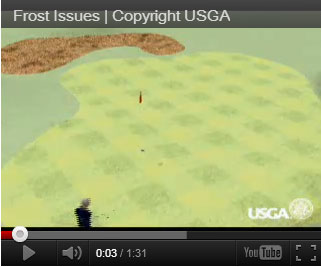With regards to frost, there is something very important that many golfers are not aware of. When we arrive at the course in the morning, it very well may be frost-free. Quite often frost develops as the sun begins to rise and can continue to develop into a heavier frost even after sunrise as the temperature tends to drop a bit. We do our best to update you with current course conditions as early and often as we can, but don't be surprised if the frost develops on the course while you are already on your way for your morning tee time.
Here are three general rules of thumb when it comes to predicting whether or not we will have frosty conditions:
Here are three general rules of thumb when it comes to predicting whether or not we will have frosty conditions:
- Frost typically occurs at temperatures of 34 degrees or lower; it does not have to reach 32 degrees as many believe.
- Clear skies increase the potential for frost; cloudy skies tend to "insulate" better, resulting in warmer air and surface temperatures.
- Wind also influences frost development. Windy conditions can prevent cold air from settling in, again resulting in warmer air and surface temperatures. That being said, if the wind temperature is below zero, it can be quite damaging to the turf.
 |
There are other factors that determine whether or not frost will develop, but these three are the most accurate when it comes to predicting it.
I could go on and on explaining the damage caused from traffic on frosty turf, but I'll leave that to the USGA Green Section Record via this video."
I could go on and on explaining the damage caused from traffic on frosty turf, but I'll leave that to the USGA Green Section Record via this video."
http://www.youtube.com/watch?v=DRcE-gUVa3M&feature=youtu.be
No comments:
Post a Comment